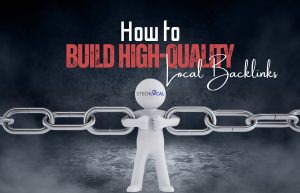Advanced Local SEO Tactics To Rank High in 2025

As local search continues to evolve, simply claiming your Google Business Profile and adding local keywords is no longer enough. In 2025, search engines will prioritize user intent, hyper-local relevance, and real-time engagement more than ever.
To stay competitive, businesses must go beyond the basics and adopt advanced local SEO tactics that align with the latest algorithm updates and consumer behavior.
This comprehensive guide highlights advanced local SEO tactics, elevates local visibility, and helps your business dominate search results.
What Is Local SEO?
Local SEO (Local Search Engine Optimization) boosts your visibility in location-based search results, making it easier for nearby customers to engage and find your business online.
It enables businesses to reach potential customers in their area precisely when searching for relevant products or services.
How Does It Work?
When users search with local intent, like “coffee shop near me” or “plumber in Chicago,” Google displays results tailored to that geographic area. These often include:
- Google Map Pack (top 3 local listings)
- Organic search results tied to location
- Google Business Profile information
Key Elements of Local SEO
- Google Business Profile Optimization: Claiming, verifying, and optimizing your listing with accurate business info, hours, photos, and services.
- Local Keywords: Using geo-specific phrases like “best dentist in Austin” in titles, content, and meta tags.
- NAP Consistency (Name, Address, Phone): Ensuring consistent business info across all online directories and citations.
- Online Reviews and Reputation Management: Earning and responding to reviews on Google, Yelp, Facebook, and niche platforms.
- Local Link Building: Getting backlinks from local directories, news outlets, blogs, and community websites.
- Mobile Optimization: Ensuring your website loads fast and displays properly on smartphones.
List of Advanced Local SEO Tactics for 2025
1: Google Business Profile Optimization 2.0

In 2025, Google evolved its local algorithm to prioritize engagement, relevance, and freshness, which means your GBP needs continuous optimization and strategic activity.
Here’s what GBP Optimization 2.0 involves:
- Complete and Enhanced Information: Go beyond the SEO basics by adding secondary categories, detailed service descriptions, product listings, and business attributes (e.g, wheelchair accessibility, women-owned).
- AI-Powered Post Scheduling: Use tools to schedule regular Google Posts, including promotions, events, and updates—Google rewards active profiles with higher visibility.
- Photo and Video Content: Frequently upload geo-tagged photos and short videos showcasing your location, services, staff, and customer experiences.
- GBP Q&A Management: Proactively answer common questions in the Q&A section, and use upvotes to signal the most helpful responses.
- Automated Review Engagement: Regularly respond to reviews with keyword-rich replies and use AI tools to analyze sentiment and identify service gaps or strengths.
- Service Areas and Geo-Targeting: Use grid tracking data to properly set and update your service areas to match high-converting zip codes or neighborhoods.
- Real-Time Updates: Stay current on your hours, holiday closures, and business details to avoid customer frustration and listing suspensions.
2: Hyperlocal Keyword Strategy
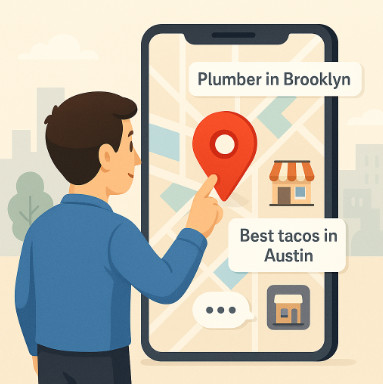
One of the most impactful advanced local SEO tactics in 2025 is developing a hyperlocal keyword strategy, targeting search terms that reflect specific neighborhoods, streets, landmarks, or zip codes rather than just broad city names.
Instead of optimizing only for “plumber in Chicago,” forward-thinking businesses now target “emergency plumber near Lincoln Park” or “leaky faucet repair near Wicker Park 60622”.
Google’s algorithm favors ultra-relevant results that match the searcher’s exact location, especially on mobile and voice searches.
Here’s how to execute this tactic:
- Use Location Modifiers: Incorporate smaller location references (neighborhoods, intersections, landmarks) into your title tags, meta descriptions, H1s, and content.
- Create Location-Specific Pages or Blog Posts: Publish tailored content like “Top 5 Coffee Shops Near Times Square” or “HVAC Repair in Dallas Suburbs: What to Know.”
- Leverage Google’s ‘Near Me’ Behavior: Use phrases like “near me,” “close to,” in a natural, user-focused way across your site and GBP.
- Geo-Targeted FAQs: Create FAQ sections that reflect location-based questions people search, such as “Is there a dentist open late in South Austin?”
- Google Trends and Geo-Grid Tools: Combine Google Trends with local rank tracking grids to discover the micro-locations where you’re most visible, and where you need improvement.
3: Advanced Citation and NAP Consistency Tactics
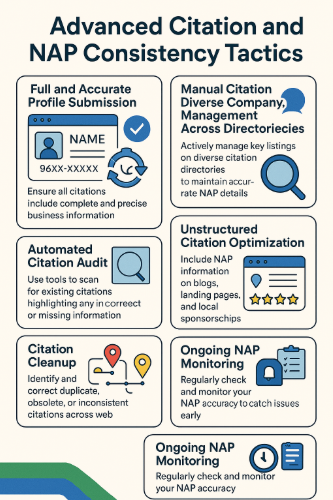
Maintaining name, address, and phone number (NAP) consistently across the web has long been a Local SEO staple. It is the evergreen local SEO tactic. However, in 2025, Google demands more precision, authority, and real-time accuracy.
Here’s how to take citation and NAP consistency to the next level:
- Audit Beyond the Basics: Don’t just check major directories like Google, Yelp, and Facebook; review niche platforms (e.g., Houzz for contractors, Healthgrades for doctors), and local chambers of commerce or regional business directories.
- Suppress Duplicate Listings: Use citation management tools to find and remove duplicate or outdated listings that could confuse Google or potential customers.
- Implement Structured Data (Schema): Add LocalBusiness schema markup to your site with your NAP details, business hours, service area, and coordinates to give search engines extra clarity. Schema markup tools can make your task easier.
- Real-Time Citation Syncing: Use tools that provide live API syncing with top directories to instantly push out updates when your hours, phone number, or services change.
- Geo-Specific Citations: Create citations on local sites or community portals based on your zip code, neighborhood, or city sub-region for greater hyperlocal relevance.
- Audit and Monitor Quarterly: Review your citation using Whitespark, or BrightLocal to spot inconsistencies or new listing opportunities.
4: Location Page SEO Best Practices
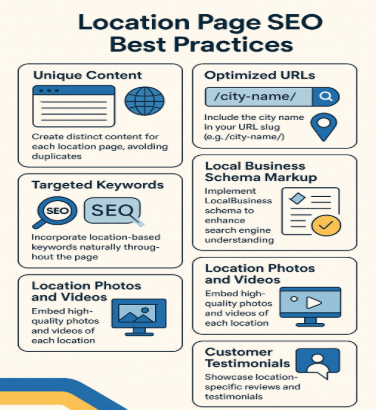
Creating well-optimized location pages is one of the most powerful advanced local SEO Tactics in 2025 for multi-location businesses, or even single-location businesses targeting nearby areas.
Search engines now reward unique, content-rich, and hyper-relevant location pages that deliver genuine value to local searchers.
Here’s how to implement best practices for high-performing location pages:
- Unique Content for Each Page: Ensure each location has unique content, including tailored service details and references specific to the local community.
- Include Full NAP Details: Display your name, address, and phone number prominently, preferably near the top and bottom of the page, and match it exactly with your Google Business Profile and citations.
- Embed a Google Map: Add an interactive Google Map with a pin on your business’s location to reinforce local relevance and improve user experience.
- Local Business Schema Markup: Add structured data to each location page to help search engines better understand your business information and connect it to local queries.
- Geo-Targeted Keywords: Use specific neighborhood, zip code, or city sub-region keywords in your H1s, meta tags, image alt text, and throughout the content naturally.
- Localized Testimonials & Reviews: Feature customer reviews that reference the specific location or services provided there. It builds trust and boosts topical relevance.
- Call to Action and Contact Forms: Include localized CTAs, appointment forms, or quote requests so visitors can immediately act without leaving the page.
- Load Speed and Mobile Optimization: Ensure every location page is fast, mobile-friendly, and fully responsive, especially for mobile users and Google’s Core Web Vitals.
- Link to Local GBP: Provide a direct link to the corresponding Google Business Profile so users can quickly access directions, hours, and reviews.
5: Voice Search and AI Optimization for Local
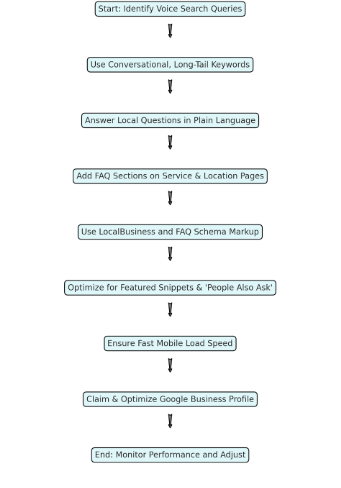
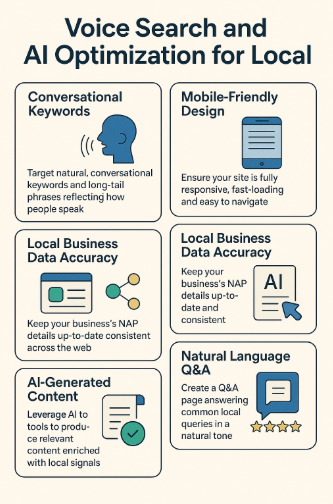
With the rise of smart assistants such as Google Assistant, Siri, Alexa, and AI-driven search behavior, optimizing for voice search and AI responses is now a crucial part of local SEO in 2025.
With the continued rise of smart assistants, over 27% of internet users now use voice search on mobile, and it’s projected that more than 50% of all local searches will be voice-based by 2025.
Voice searches are often local, action-driven, and phrased in natural language, meaning your local SEO strategy must adapt to how people speak, not just how they type.
- Use Conversational Keywords: Integrate long-tail, natural-sounding phrases into your content and FAQs. For example, instead of “dentist downtown Dallas,” use “Where can I find a dentist open late in downtown Dallas?”
- Answer Local Questions Clearly: Create dedicated content or FAQ sections that answer common voice queries like “Is there a coffee shop open near me?” or “What’s the best pizza place in Brooklyn?”
- Optimize for Featured Snippets: Structure your content with clear headings, bullet points, and direct answers to increase the chances of being pulled into voice-enabled answers and Google’s “People Also Ask” results.
- Use Structured Data Markup: Implement schema (especially LocalBusiness and FAQ schema) so search engines can better interpret and serve your content in AI-driven results.
- Focus on Page Speed and Mobile UX: Voice search is closely tied to mobile. Fast-loading, mobile-optimized pages improve your chances of ranking in voice search results.
According to Google, 46% of all searches now have local intent, reinforcing the need for businesses to show up where and when customers are searching nearby.
- Claim and Optimize Google Business Profile: Voice assistants often rely on Google’s local data, having a complete, frequently updated Google Business Profile helps ensure your business is included in spoken results.
- Create Audio-Friendly Content: Create content that is easy to understand when spoken aloud. Keep it clear, concise, and informative to perform well in voice search results.
6: AI and Automation in Local SEO

AI and automation are transforming how businesses approach local SEO, making it faster, smarter, and more scalable. By providing actionable insights, AI helps local businesses to enhance performance, reduce manual workload, and stay ahead of the competition.
AI Automation Tool Comparison
| Tool | Use Case | Best For |
| ChatGPT | AI content generation & chat support | FAQs, review replies, chatbots |
| Surfer SEO | On-page content optimization | Blog posts, landing pages |
| Yext | Business listing sync & updates | GBP sync, location updates |
| MarketMuse | Content strategy & optimization | Topic cluster planning |
Below is how AI and automation enhance local SEO strategy:
- AI-Generated Content: AI tools can create optimized meta descriptions, service page content, and FAQs tailored to specific locations and keywords, helping you scale content production without sacrificing quality.
- Review Monitoring and Sentiment Analysis: AI can analyze thousands of reviews across platforms to detect sentiment trends, highlight recurring issues, and suggest improvements, all without manual effort.
- Chatbots and Voice Assistants: AI-powered chatbots integrated into your site or Google Business Profile can answer common customer questions, provide directions, or assist with bookings, boosting user experience and engagement.
- Smart Scheduling for Posts and Updates: Automation tools let you schedule Google Posts, social content, and seasonal business hour changes in advance, ensuring your online presence stays fresh and active.
- Competitor Monitoring: AI-driven tools can track how competitors perform in local rankings, reviews, and listings, giving you insights to refine your strategy.
- Dynamic Geo-Ranking Insights: AI helps analyze how your business ranks across different locations in real time and suggests hyperlocal opportunities for improvement.
7: Reputation and Review Management in 2025
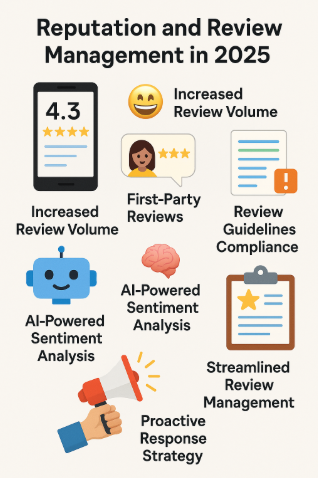
Online reputation is more than just a trust factor; it’s a local ranking signal and a direct driver of conversions. Google and other platforms continue to give significant weight to review quality, frequency, and responsiveness when determining local search rankings.
72% of consumers say they only engage with businesses that have a rating of 4 stars or higher, making review quality and frequency critical for conversion.
Here’s how to stay ahead with review management:
- Automated Review Generation: Use tools to send timely, personalized review requests via email or SMS after a customer interaction, improving response rates and building fresh review volume.
- AI-Powered Sentiment Analysis: Leverage AI to scan review trends, detect recurring issues, and gain insights to improve customer experience.
- Respond to All Reviews: In 2025, responding to positive and negative reviews is essential for customer engagement and improving your visibility in Google’s local algorithm.
53% of customers expect a response to negative reviews within 7 days, which directly influences both reputation and local rankings.
- Review Diversification: Encourage reviews across multiple platforms, including Google. Yelp, Facebook, and even niche local directories contribute to your credibility and ranking profile.
- Showcase Reviews as Social Proof: Share positive reviews on your website, Google Posts, and social media to boost brand trust and influence purchase decisions.
- Review Velocity and Freshness: Search engines favor businesses with a steady flow of recent reviews. Set up automated reminders and incentives to keep your review stream active and current.
- Multi-Location Reputation Management: For businesses with multiple branches, use centralized platforms to manage and track reviews by location, ensuring no feedback goes unnoticed.
8: Local Link Building and Digital PR
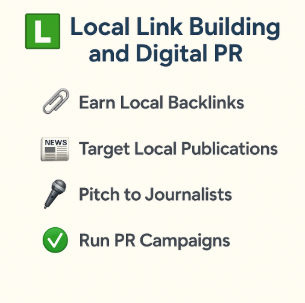
Local link building and digital PR remain essential for boosting authority, trust, and local search rankings. Google continues to value high-quality backlinks, especially those from relevant, geographically specific sources, as a strong signal of credibility.
Advanced strategies now combine traditional outreach with PR-driven content to earn placements that directly impact your local SEO performance.
Here’s how to execute effective local link building and digital PR:
- Earn Local Backlinks from Trusted Sources: Partner with local blogs, newspapers, chambers of commerce, schools, and event websites to get featured or listed. These links carry strong local relevance and authority.
- Create PR-Worthy Content: Develop locally relevant, newsworthy content, such as community initiatives, charity drives, customer success stories, or expert guides, that media outlets or bloggers would want to share.
- Sponsor Local Events or Causes: Sponsorships often come with backlinks from event pages or partner websites. Look for opportunities in local sports, non-profits, business expos, or school events.
- Claim Unlinked Brand Mentions: Use tools like Google Alerts to find mentions of your business that don’t link back, and politely request a link from the publisher.
- Build Local Resource Pages: Create pages that list top local resources, vendors, or tips, and include yourself among them. This helps establish you as an authority while encouraging reciprocal links.
- Use Digital PR Tools and Platforms: Help a Reporter Out (HARO), Qwoted, or local journalist databases can help you connect with media professionals seeking expert commentary, leading to high-authority local press features.
- Leverage Local Awards and Directories: Apply for “Best of” lists, local business awards, and industry-specific recognitions that often come with authoritative backlinks and PR exposure.
9: Tracking, Analytics, and KPIs for Local SEO

In 2025, leveraging accurate data and performance metrics is critical for executing advanced local SEO tactics and staying ahead of the competition.
With evolving search behaviors and frequent algorithm updates, precise tracking and well-defined KPIs help measure what’s working, identify gaps, and optimize your local SEO strategy effectively.
Here’s how to execute effective tracking, analytics, and KPIs for local SEO:
- Use Google Business Profile Insights (GBP Insights): Track key metrics such as search impressions, calls, website clicks, and direction requests. These offer a real-time view of how users interact with your listing.
- Monitor Local Pack Visibility: Track your presence in Google’s Local Pack (Map Pack) for primary and secondary keywords. This is where most high-intent local search clicks happen.
- Track NAP Consistency and Citation Health: Use tools to monitor the accuracy across directories of name, address, and phone number (NAP). Inconsistent data hurts trust and rankings.
- Analyze Review Volume and Sentiment Trends: Monitor review quantity, ratings, and sentiment across platforms like Google, Yelp, and Facebook. Positive review growth is a key signal for local ranking.
- Measure On-Page Engagement Metrics: Use Google Analytics and tools like GA4 to track bounce rate, time on page, and conversion rates (form fills, calls, bookings). These metrics indicate how effectively your website converts local traffic.
- Monitor Backlink Quality and Local Link Acquisition: Track the number and quality of local backlinks earned through digital PR and outreach campaigns using tools like Ahrefs or Moz.
- Define Clear Local SEO KPIs: Set measurable goals, including an increase in Local Pack rankings, review the acquisition rate, growth in calls or direction requests, and geo-specific traffic growth.
Studies show that businesses that appear in both the Local Pack and organic listings enjoy 10x greater visibility than those that rank in only one, highlighting the value of a unified SEO strategy.
10: Proximity Grid & Local Search Heatmap Targeting
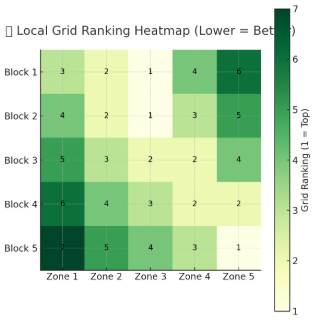
Google’s local algorithm in 2025 is now geo-behavioral, rewarding businesses that show consistent engagement and visibility across hyperlocal map segments. By using grid-based proximity tracking and local search heatmaps, businesses can identify exactly where they’re strong (or invisible) on the map—and take action.
What To Do:
- Use Geo-Grid Rank Tracking Tools: Track how your business ranks in the Map Pack for multiple pinpoints across a city, neighborhood, or zip code (e.g., every 500 meters).
- Analyze Drop-Off Zones: Identify areas where your visibility sharply drops and optimize them with geo-tagged posts, localized landing pages, and GBP content updates.
- Target Micro-Clusters: Focus your outreach, content, and link building around zones where you’re almost ranking (positions 4–6). A small push there can yield huge visibility wins.
- Overlay Heatmaps with Real-World Data: Combine search visibility heatmaps with offline data (sales, foot traffic, deliveries) to fine-tune your targeting and budget allocation.
- Monitor Competitor Visibility by Grid: See where competitors dominate and where they’re weak—and fill those gaps with aggressive localized content and reputation strategies.
Why Local SEO Still Matters in 2025?
Despite rapid advancements in AI, automation, and digital advertising, Local SEO remains a cornerstone of online visibility for businesses in 2025.
In 2025, the businesses that dominate local SEO are those that combine automation, hyperlocal strategy, and constant GBP engagement.” – Akmal Faizan, Founder, Stech Local
As consumers increasingly turn to voice search, mobile devices, and hyper-local queries like “best coffee shop near me” or “emergency plumber open now,” Google’s local algorithm prioritizes proximity, relevance, and trust signals.
In fact, 78% of local mobile searches result in an offline purchase, making local SEO one of the highest-converting digital strategies available.
A recent study found that 93% of consumers used online searches to find a local business in the past year—proof that local visibility is no longer optional.
- High-Intent Traffic: Local searches often come from users ready to take immediate action, like calling, visiting, or making a purchase. Local SEO helps your business show up when someone needs your service.
- Mobile-First Search: With over 60% of searches happening on mobile, local listings and map results have become the first stop for nearby consumers. An optimized local presence ensures your business is visible in those critical moments.
- Voice and AI Search Growth: Devices like Alexa, Siri, and Google Assistant rely heavily on local SEO data to answer “near me” questions. If your business isn’t properly optimized, you’re missing out on this growing traffic source.
- Trust and Reviews: In 2025, reviews and ratings are even more influential. Local SEO integrates review management, helping businesses build credibility that directly impacts search rankings and customer trust.
- Zero-Click Searches: With Google displaying more answers directly in the SERPs, having a well-optimized Google Business Profile ensures users can find key info, including hours, phone numbers, directions, without needing to visit your website.
Real-World Case Studies: Advanced Local SEO in Action
The following examples demonstrate how applying the right local SEO strategies can significantly improve search rankings, review volume, and call conversions.
1. Dental Clinic: Improving Grid Ranking & Reviews
A family dental clinic in San Diego had inconsistent NAP data, a barebones Google Business Profile, and low visibility in surrounding neighborhoods despite a solid reputation.
Tactics Applied:
- Built hyperlocal landing pages for each neighborhood (e.g., “Invisalign in North Park”)
- Added 50+ geo-tagged photos of the clinic, team, and services
- Implemented GBP Optimization 2.0 with weekly posts and FAQ updates
- Deployed an automated review request system via SMS
- Used AI-based grid tracking to target high-opportunity zip codes
Results (within 90 days):
- Moved from grid position 7 ➝ 2 for “pediatric dentist near me”
- Increased reviews from 38 ➝ 112, with a 4.9 average rating
- 2.6x increase in phone call conversions via Google Profile
2. Real Estate Brokerage: Dominating Local Visibility
A real estate agency in Austin struggled to compete with larger firms in local pack rankings for high-intent keywords like “homes for sale in East Austin.”
Tactics Applied:
- Created service area pages per neighborhood with embedded listings and local insights
- Optimized GBP with property walkthrough videos and pinned Google Maps
- Engaged in local digital PR: got featured in a community newsletter and real estate blog
- Set up a chatbot on GBP to answer common buyer/seller questions
- Responded to every review using keyword-rich responses
Results (within 60 days):
- Entered the 3-pack for 5 high-volume real estate keywords
- Increased search visibility by 87% in targeted micro-areas
- Doubled weekly inquiries and call-back requests via GBP messaging
3. Law Firm: Converting Reviews into Clients
A multi-location law firm in Chicago wanted to improve lead generation for its criminal defense and family law practices through localized SEO.
Tactics Applied:
- Added unique, location-optimized content to each practice area page
- Deployed AI to analyze review sentiment and identify key service strengths
- Ran a “Client Experience” campaign to proactively gather reviews post-case
- Claimed unlinked brand mentions on legal directories and press mentions
- Used voice search optimization by answering natural queries like “Is there a divorce lawyer open on weekends?”
Results (within 75 days):
- Improved average grid ranking from 5.3 ➝ 2.1 in 4 zip codes
- Review count rose from 89 ➝ 193 across 3 locations
- 38% increase in direct calls from local search listings
Read Also: Using Schema Markup to Boost Local Rankings
Summary
What Is Local SEO?
Local SEO improves your online visibility in area-specific searches, helping nearby customers find and engage with your business when they need your products or services.
Key Elements of Local SEO
- Google Business Profile Optimization
- Local keywords
- NAP consistency (name, address, phone)
- Online reviews and reputation management
- Local link building
- Mobile optimization
List of Advanced Local SEO Tactics for 2025
- Google Business Profile Optimization 2.0
- Hyperlocal keyword strategy
- Advanced citation and NAP consistency tactics
- Location page SEO best practices
- Voice search and AI optimization for local
- AI and automation in local seo
- Reputation and review management in 2025
- Local link building and digital PR
- Tracking, analytics, and KPIs for local SEO
- Proximity grid & local search heatmap targeting
Why Local SEO Still Matters in 2025?
- High-intent traffic
- Mobile-first search
- Voice and AI search growth
- Trust and reviews
- Zero-click searches
Real-World Case Studies: Advanced Local SEO in Action
- Dental Clinic: Improving Grid Ranking & Reviews
- Real Estate Brokerage: Dominating Local Visibility
- Law Firm: Converting Reviews into Clients
FAQs
What are the most effective local SEO tactics for 2025?
Some of the most effective local SEO tactics for 2025 include:
- Google Business Profile Optimization 2.0
- Hyperlocal keyword strategy
- Advanced citation and NAP consistency tactics
- Location page SEO best practices
- Voice search and AI optimization for local
- AI and automation in local seo
- Reputation and review management in 2025
- Local link building and digital PR
- Tracking, analytics, and KPIs for local SEO
How is local SEO different in 2025 compared to previous years?
In 2025, local SEO is more dynamic, emphasizing AI-driven search, voice queries, real-time engagement metrics, and Google Business Profile optimization.
Unlike previous years, success depends heavily on user intent, review quality, and localized content relevance rather than just citations and backlinks.
How has Google Business Profile evolved in 2025?
In 2025, Google Business Profile emerged as a more interactive and AI-powered platform, offering enhanced features like real-time messaging, AI-generated FAQs, service-based booking, and dynamic content updates.
It plays a central role in local SEO by focusing on user engagement, trust signals, and up-to-date information.
How do I fully optimize my Google Business Profile in 2025?
To optimize your Google Business Profile, use complete and accurate business info, use high-quality photos and videos, enable messaging, regularly post updates, and collect and respond to reviews.
Keep services, hours, and attributes up to date for maximum visibility and engagement.
What new Google Business Profile features should I use in 2025?
Some of the Google Business Profile features you should use in 2025:
- AI-Powered Insights & Suggestions
- Smart Messaging Enhancements
- Video Cover and Short Reels
- Scheduled Posts, Offers, and Promotions
- Enhanced Q&A and Review Moderation
- New Trust and Sustainability Badges
Why is local SEO important for small businesses in 2025?
Local SEO is essential for small businesses in 2025 because it helps them appear to nearby customers when searching. It boosts trust through reviews and accurate listings, and drives more foot traffic, calls, and conversions, without the high cost of traditional advertising.
What role does AI play in local SEO optimization?
AI plays a key role in local SEO optimization by analyzing user behavior, personalizing search results, generating content suggestions, managing reviews, and enhancing listings with smart insights, helping businesses rank higher and engage more effectively with local audiences.
What are the best tools to track local SEO performance in 2025?
Some of the best tools to track local SEO performance include:
- Google Business Profile
- Google Search Console
- GA4 (Google Analytics 4)
- BrightLocal
- Whitespark
- Moz Local
- Semrush
What are geo-tagged images, and do they help local SEO?
Geo-tagged images are photos embedded with location data (like latitude and longitude). It helps local SEO by reinforcing your business’s geographic relevance, especially on platforms like Google Business Profile, enhancing local visibility and trust.
How can I use chatbots to improve local search engagement?
You can use chatbots to improve local search engagement by providing instant responses to customer queries, guiding users to services or locations, capturing leads, handling FAQs, and integrating with Google Business Profile messaging to boost responsiveness and local trust.
